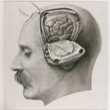Monday, 3 September 2012
The beginning of modern neurosurgery
 Probably the oldest form of neurosurgery is trepanation, which consisted in drilling a hole in the skull to allow evil spirits to escape from the brain. For example, scientists have found the skull of a young girl who was trepanned with a flint instrument in about 3 500 BCE. What is most remarkable are the scars suggesting that she survived this operation.
Probably the oldest form of neurosurgery is trepanation, which consisted in drilling a hole in the skull to allow evil spirits to escape from the brain. For example, scientists have found the skull of a young girl who was trepanned with a flint instrument in about 3 500 BCE. What is most remarkable are the scars suggesting that she survived this operation.
Modern neurosurgery did not really begin until the late 19th century, when surgeons opened the meninges to operate directly on the brain. But these first years were difficult ones: the survival rate for any surgical procedure that involved opening the skull was only 10%!
Then came American surgeon Harvey Cushing (1869-1939), now regarded as the father of modern neurosurgery. In the early 20th century, he developed a great many new techniques that increased the survival rate for neurosurgery spectacularly, to over 90%!
Cushing wasn’t afraid to improvise new solutions to the problems posed by neurosurgery. For example, the biggest problem was that, because brain tissue is so densely vascularized, patients often bled to death. Cushing therefore developed all sorts of small tools to prevent the blood vessels in the brain from bleeding too much, such as small clips that could be used to pinch off blood vessels and stop the hemorrhaging.
Cushing was also a talented artist. Immediately after each operation, he would make drawings that contained a great deal of information about the way that he had opened the skull, the parts of the brain that he had touched, and so on.
Cushing is estimated to have successfully removed more than 2 000 brain tumours in the course of his career. He conducted his 2 000th brain tumour operation almost exactly 80 years ago today, on April 15, 1931! The first link below will take you to an excerpt from the film shot during this operation.
![]() Harvey Cushing’s 2000th tumor resection
Harvey Cushing’s 2000th tumor resection
![]() Video: Inca Trepanation
Video: Inca Trepanation
![]() Harvey Cushing photo journal
Harvey Cushing photo journal
![]() Dr. HARVEY CUSHING – A BOOK OF PHOTOGRAPHS
Dr. HARVEY CUSHING – A BOOK OF PHOTOGRAPHS
![]() L’histoire de la Neurochirurgie, par Bernard Alliez
L’histoire de la Neurochirurgie, par Bernard Alliez
From the Simple to the Complex | Comments Closed







